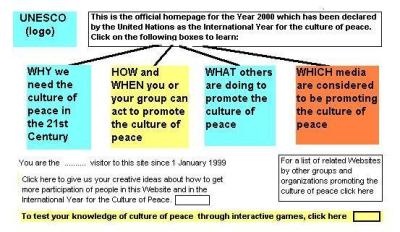Stories
UN Declaration and Programme of Action for a Culture of Peace
Personalities in the "culture of peace bed"
From the earliest days of the Culture of Peace Unit in 1994, I emphasized in my discussions with Director Leslie Atherley the need for networking with civil society organizations involved in the various aspects of a culture of peace. Each time I would come back from a mission, I would return with cards from dozens of interested civil society organizations. Some idea of the richness of the contacts can be seen from the last chapter of the culture of peace monograph that I wrote at that time. We needed a system to store the data and to keep in touch with these organizations. Since I was busy with national programmes, the task was given to Myriam Karela who had come into the Unit after assisting me previously in the Social Science Sector.
Myriam was not up to the task and soon she began to complain that I was expecting too much from her. Fortunately, about that time we got a very bright young intern, Ramin Kaweh, who set about designing an excellent computer-based system for the information. Unfortunately, his internship ended before he could complete the work, and although we had the help of a young Israeli woman from the IT department, she, too, did not complete the task.
In 1995 we hired Mischa Mills who took charge of information and networking. She did the task reasonably well, but by 1997 she was leaving for a career in the Commonwealth Secretariat, and the task was once again open.
Leslie wanted to give the task back to Myriam, but I said that I would undertake it instead and develop an Internet-based news network to link up all of the civil society organizations that we had already contacted, as well as new ones that we could involve. I had already determined that the national programmes in which I had been involved for several years could not succeed because of opposition from the powerful Member States, so we needed a new approach. Leslie was not convinced by the proposal and refused to agree to it.
For weeks there was a power struggle in the Unit, which I documented in my notebooks from June 11, 1997. At first Leslie defended Myriam, but On July 24, I met with Director-General Mayor and asked for a new assignment to make the information network, which I called at that time, the "Infonet". The new assignment did not come for many months, however, and the conflict in the Unit culminated in April 1998 in what I call the UNESCO Inquisition. During the intervening months, I had given Mayor a budget for the Infonet and he obtained $100,000 for it from the new funds associated with the return to UNESCO of the United Kingdom.

Original design for homepage of Infonet - 1997/1998>
(click on design for enlargement)
The first person that I hired in my new unit for the International Year was Zeynep Varoglu, the brightest of the young professionals who had just come into UNESCO, and I gave her the task of developing the network, now called the Culture of Peace News Network. Over the next few years, Zeynep designed and carried out training modules and designed much of the draft Internet system. In my archives are hundreds of pages of projects, missions, analyses and reports that she carried out with extremely hard work and great intelligence. After a year or so she was joined in the CPNN development by Di Bretherton who came on sabbatical from Australia.

CPNN Internet training in Beijing with Zeynep Varoglu and Katerina Saliagina in the center
(click on photo for enlargement)
Convinced that we needed CPNN websites in all the languages of UNESCO, I used the $100,000 to establish a series of contracts in France, Spain, Jordan, Moscow, Greece and Macedonia and sent Zeynep, Di and a young Latin American, Sergio Sarmiento on missions to Jordan, Latin America, United States and China in order to develop CPNN sites. Non-contractual initiatives were also begun with the International School in Paris, the World Scout Movement in Geneva and the AARP in the United States. Unfortunately, as soon as the contracts ran out, so did the work from all of the contractual partners, which taught me a hard lesson on the limits of using money to develop what must ultimately be a labor of love and commitment. And in the non-contractual cases, the projects ended when the key person left the organization concerned.
In the end, the only CPNN site to survive was the only one that did not receive money from UNESCO, the Japanese site established by Takehiko Ito.
Given the successful mobilization of thousands of civil society organizations in the Manifesto campaign of the International Year in 2000, I expected that CPNN would be able to pick up where that had left off, and that was to be my priority when I left UNESCO. For that history see CPNN-2.
 |
Stages
1986-1992
Fall of Soviet Empire
1992-1997
UNESCO Culture of Peace Programme